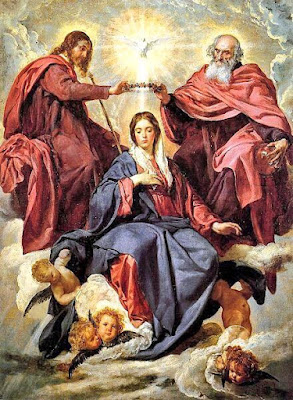Monday, December 13, 2021
SI JOSÉ YAN SI MARÍA
Monday, December 6, 2021
NINA'HUYONG YU'US TÅTA
Wednesday, November 17, 2021
GUAM DURING PROHIBITION
Wednesday, November 10, 2021
ANGLOPHOBIA OF 1800
ANGLOFOBIA DE 1800
Si caminamos por la ciudad de Agaña y miramos hacia arriba
en dirección a los Altos de Agaña, veremos más de una estructura de la época
española, todo gracias a un solo hombre:
Manuel Muro, gobernador de las Islas Marianas desde 1794
hasta 1802.
Quizás más que cualquier otro gobernador español, Manuel
Muro construyó mucho y todavía podemos ver bastante de todo aquello edificado.
Levantó el Fuerte Santa Águeda (abajo en la foto), también
conocido como Fuerte Apugan. Construyó el Puente Español en Agaña, más
propiamente conocido como el Puente de San Antonio y coloquialmente por nuestra
propia gente como el Tollai Åcho' (puente de piedra).
Hay unas paredes detrás de la Azotea en el Palåsyo (Palacio
del Gobernador) que él construyó. Todas estas obras han sobrevivido a guerras y
calamidades naturales y todavía se pueden ver.
Pero hay más de lo que construyó Manuel Muro que ya no se
puede apreciar, habiendo sido víctima de la destrucción tanto natural como
provocada por el hombre.
Construyó el Fuerte Santa Cruz, que se encontraba en el
Puerto de Apra. Construyó otro fuerte, el San Rafael, más cerca de la costa de
Agaña, cerca del edificio principal del Bank of Hawaii, en la actualidad. Y
además de éstos, construyó otros proyectos más pequeños, que desde entonces han
ido desapareciendo.
Manuel Muro construyó todas estas cosas, naturalmente, con
mano de obra chamorra, obligados a trabajar en proyectos de construcción del
gobierno un número determinado de días al año, en lugar de pagar impuestos. La
gente pensaba que Manuel Muro los hacía trabajar hasta la extenuación.
Fuerte San Rafael - 1799
Fuerte de Santa Águeda - 1800
Fuerte Santa Cruz - 1801
¿Por qué fueron construidos todos estos fuertes? ¿Y en un
corto período de tiempo, de 1799 a 1801, es decir, solo tres años?
Durante siglos, Inglaterra y España fueron enemigos.
Pensemos en la Armada Española en 1588. El conflicto entre
las dos naciones continuó, y a menudo involucró a piratas británicos que
acosaban a los barcos españoles cargados con riquezas de Hispano-América y
Asia. Algunos de los corsarios británicos incluso llegaron a Guam, como William
Dampier y Woodes Rogers.
En 1762, mientras Inglaterra y España estaban en guerra, los
británicos lograron conquistar Manila y permanecieron allí durante dos años
hasta que terminó el conflicto, luego fueron expulsados.
Treinta y cuatro años después, en 1796, España y Francia se
unieron contra Inglaterra. Napoleón Bonaparte ya era una estrella militar en
Francia, y pronto sería gobernante de ese país pasando a conquistar gran parte
de Europa y luchando también contra los británicos. Francia fue otro rival
histórico de Inglaterra, por lo que España y Francia terminaron del mismo lado
contra los ingleses.
Entonces, cuando Manuel Muro era gobernador de las Islas
Marianas, España quería que sus territorios de Asia y el Pacífico se prepararan
para un posible ataque de los británicos.
En las Filipinas, en 1800, el gobernador general ordenó a
todos los hombres aptos que formaran una milicia, que recogieran armas y las
usaran contra los británicos si era necesario. Según los periódicos de la
época, todo Filipinas temía otra invasión británica. Las ciudades costeras se
vaciaron a medida que la población se trasladaba tierra adentro.
Los periódicos británicos hablaron de la ansiedad que
sentían los líderes españoles en Manila y del mal estado de los militares,
milicias y buques de guerra españoles. Los británicos ya estaban en la India, y
los españoles en Manila creían que se podía lanzar un ataque británico desde
allí. Los británicos no solo estaban en la lejana Europa, ya estaban en Asia.
De modo que los ajetreados proyectos de construcción de
Manuel Muro en Guam desde 1799 hasta 1801 eran casi sobre lo mismo; preparar a
Guam para un ataque británico que al final, nunca llegó.
Los británicos derrotaron a los franceses y españoles en
Trafalgar en 1805. La propia España fue ocupada por Francia en 1808, pensando que
podría hacer un mejor trabajo dirigiendo el gobierno de su aliado. España se
rebeló contra esta ocupación y comenzó la guerra entre Francia y España. España
siguió decayendo, perdiendo la mayor parte de sus territorios en
Hispano-América en 1821. Los británicos no tenían que preocuparse por España en
absoluto.
Sin embargo, debido al temor de un ataque británico que
nunca llegó, se construyeron fuertes españoles en Guam, que nunca presenciaron
batalla.
Así que, la próxima vez que miremos hacia el Fuerte Santa
Águeda (Apugan), quizás recordemos que todo eso fue construido en Guam porque
los españoles en 1800 estaban pensando en los británicos.
Wednesday, October 27, 2021
ÅNTES YAN PÅ'GO
Wednesday, October 20, 2021
CHURCH PEWS
Tuesday, October 12, 2021
ABSENTEE HUSBANDS
Tuesday, September 28, 2021
THE ROCK AT THE FORK
Wednesday, September 22, 2021
KÅNTA : I PUTI'ON KAHULO'
Wednesday, September 15, 2021
TURTLE ISLAND IN CHAMORRO
People in the recent past looked at the island and called it Turtle Rock. In Chamorro, that would be Åcho' Haggan, or maybe Isletan Haggan (Turtle Islet). There is only one reference to Turtle Rock in the Pacific Daily News in the 1970s, and none in the 1950s and 60s. We'd have to check the prewar Guam Recorder and other prewar literature to see if there was anything called Turtle Rock, but I'm skeptical. So it seems the name "Turtle Rock" became standard only after the war.
So what did the Chamorros call this island or rock?
Perhaps, then, Åcho’ Nihi (Nihi Rock) or Isletan Nihi (Nihi Islet). I have no idea if Nihi is the same as the Chamorro word nihi which means “let’s.” Or, if the name Nihi comes from another source.


































